I was at a family reunion a few years back. We had four generations at the farm that my grandparents purchased many many years ago. My dad grew up on this patch of heaven, his sister and husband took over the farm and raised their family, then their son and family moved in when my aunt and uncle moved to their lake house. Maybe someday their daughter will raise her family here.
Long ago, my grandfather and grandmother had children and became a family of five. Their three children married and had children and we were a family of 14. As the children’s children married and had their children, we are now 39. Yes, some are gone now, but they are still with us, in our history, in our stories, and in our hearts.
As I was looking at how 2 became 39, I was thinking this week’s game will be about multiplication. Piggyback Race from the Math Card Games book written by Dr. Joan A. Cotter. This is game P11 from the multiplication chapter.
This is a great game for younger learners or for those needing to brush up on their multiplication skills. If a child is needing some assistance, have them use an AL Abacus or the Skip Counting Patterns. The winner of the game is decided totally by chance and it’s a blast!
Choose a set of Multiplication cards. Let’s use the 3s today. So we need the ten multiples of 3: 3, 6, 9, 12, 15, 18, 21, 24, 27, and 30. We’ll also need 12 Basic Number cards of the same number as the set chosen, 3s in our game here. So that’ll be twelve 3-cards. We’ll also need four 0-cards from the basic number cards too. That comes to 10 multiplication cards and 16 basic number cards.
We will need two players. Or two teams if you have extra kids that want to play. We’ll also need two markers that can be stacked. Personally, I like those flat erasers or colored tiles.
Lay out the multiplication cards in a row. Leave a gap after the fifth card. This helps the players quickly identify the card placement. Shuffle the basic number cards and turn them face down to form the stock.
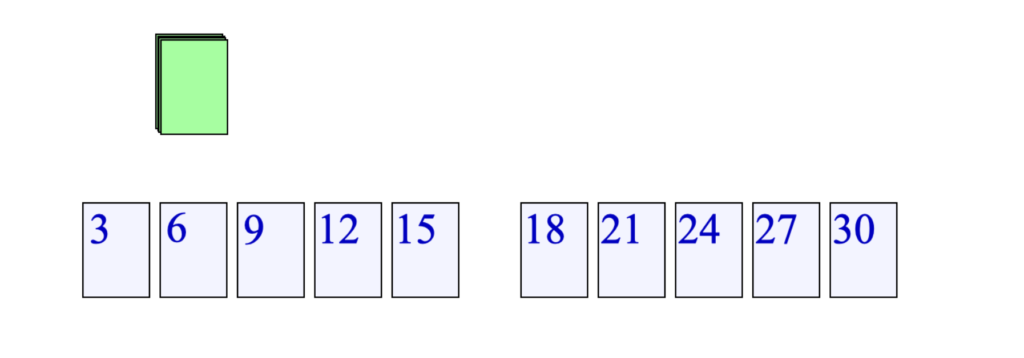
To start, place both markers at the starting of the row. The first player turns over a card from the stock. If it’s a 3, she then moves her marker to the first card and says, “3 taken 1 time is 3.”
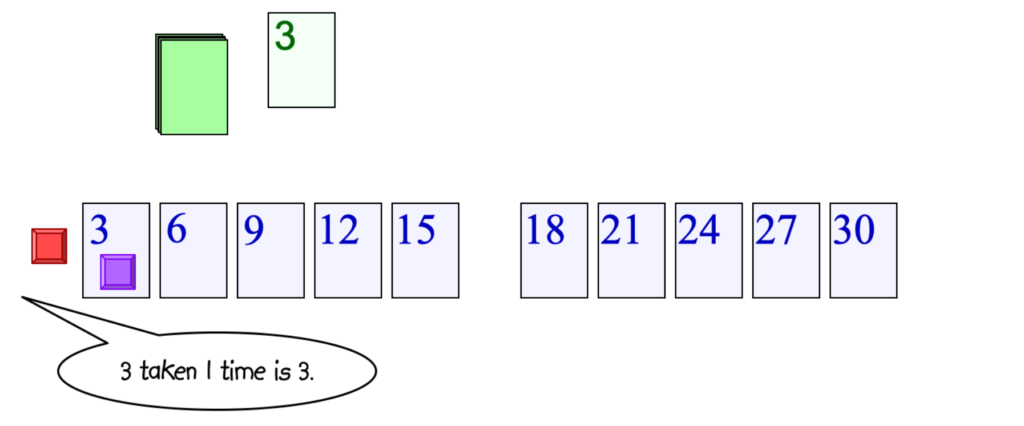
The players continue taking turns and stating the appropriate facts: “3 taken 2 times is 6,” and “3 taken 3 times is 9,” and so on.
If the card turned over is a 0, they cannot move and it’s the next player’s turn.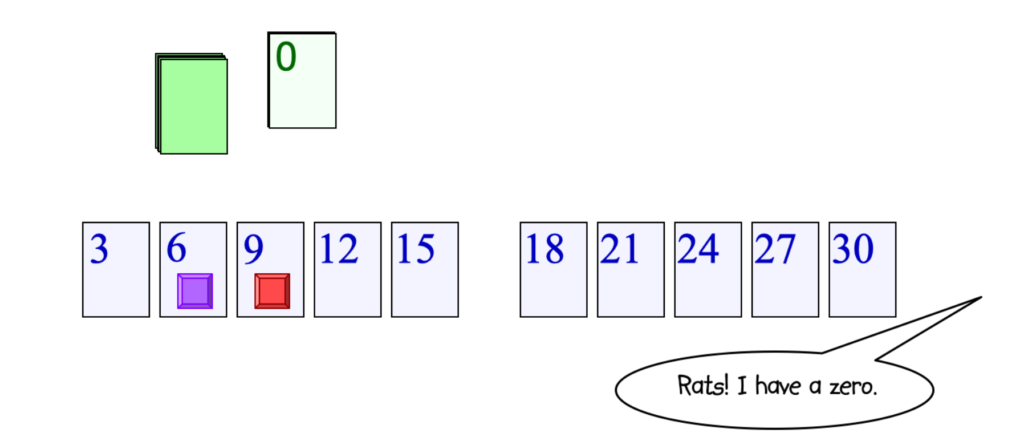
What if a player lands on a card with a marker already in place? She puts her marker on top of the first one.
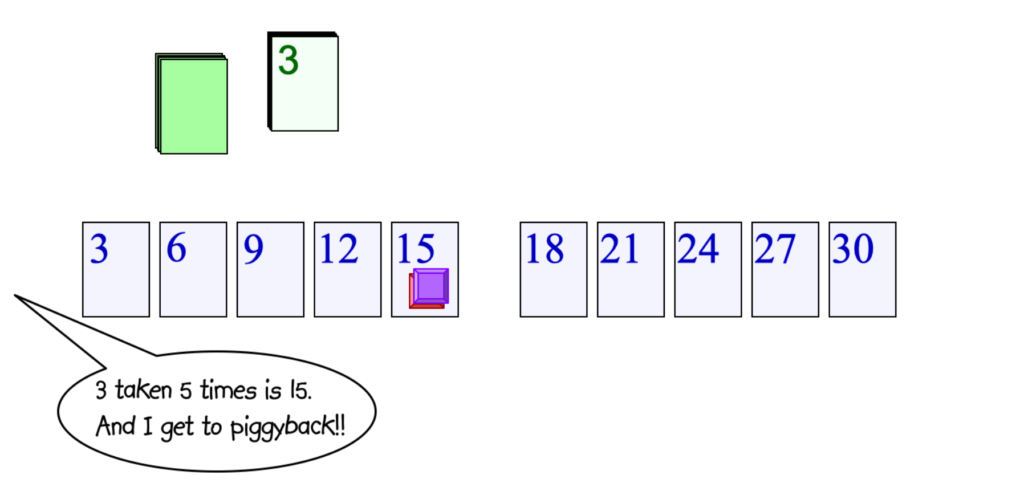
If the bottom marker moves, he’ll take the other player with him as a “rider”! But the top marker can move off the first anytime she has a card to move her along.
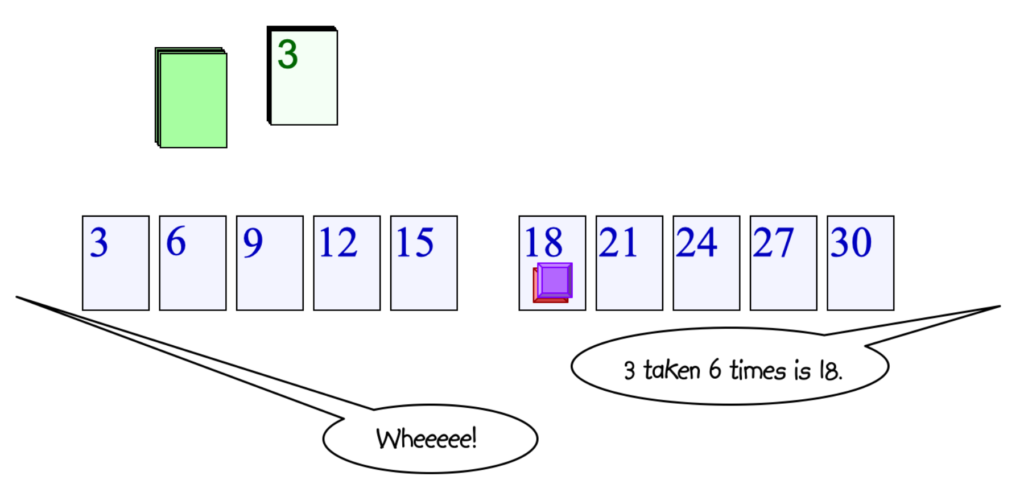
If the basic number cards are all used up, shuffle and re-use them. The winner is the first person to move down the line to the last card. Although this isn’t a super complicated game, it’s fun. More importantly, the kids are practicing their multiplication facts!
So go play this review game. Next week, I’ll have a more advanced game for you. Practice up on this one to get ready for the next game….

I’m a private tutor and am trying to figure out how many decks of multiplication cards I need to buy along w/the book. Are 2 decks enough?
Hi, Jami. My name is Rachel and I am happy to help you today.
Two decks should be good, depending on how many children you will be tutoring together. I am assuming you are keeping the cards with you and not sending them home with the students.
You may want to get an extra set of envelopes or you can copy the multiples from the back of the Math Card Games Manual.
Have a great day!
Rachel
Are the facts done in order? if they draw a 9 and havent done 3 times 2 yet, do they lose a turn?
Hi!
So, the only numbers pulled for the basic card deck is the multiple and 4 zeros. For example, if you decide to work on the multiples of 3, then you pull 12 three number cards and 4 zeros.
The child will draw either the 3 or a 0. Then the student simply says the multiple they are heading toward.
For example, if the student is on the third card on the game board (9), and they draw a 3, then the child says, ‘4 x 3 equals 12’. If the child draws a ‘0’, then they stay on the same card (lose their turn).
I hope that helps. Of course, please do not hesitate to repost here if you have any additional questions.
Happy game playing!
Rachel
I’m a little confused. Sorry if it is obvious. How does one move forward? If I first get a 5, I go to 15, correct? If my next turn I get a 3, do I go back to 9? Or do I move forward to 24? What would I say? 3 taken 3 times is 9 (then move to 24)? Or what? I’m new to RSM, and I’m looking forward to playing the games with my kids.
I just saw the new post above. That helps me understand more. The only choices are 3s or zeros.
Yes, Melinda.
The only cards your child can draw are the 3’s and the 0’s.
Let me know if you still have questions!
Happy game playing!
Rachel